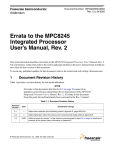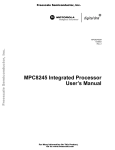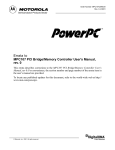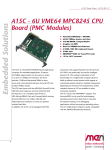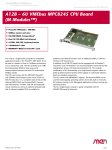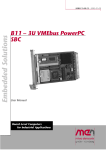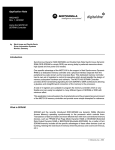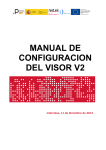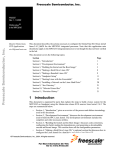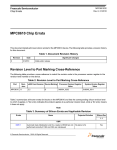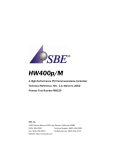Download Revision History of the MPC8245 Integrated Processor User`s Manual
Transcript
Supplement MPC8245UMHIST/D Rev. 0, 11/2001 MPC8245 User Manual Revision History Revision History of the MPC8245 Integrated Processor User’s Manual This document lists the differences between revision 0 and revision 1 of the MPC8245 Integrated Processor User’s Manual. Revision 1 of the manual with these changes incorporated is posted on the Worldwide Web at http://www.motorola.com/semiconductors. Each item below refers to the section and page number in Revision 0 of the user’s manual. Section, Page Change 1.1.1, 1-4 The second bullet under the Memory Interface heading should state: – High-bandwidth data bus (32- or 64-bit) to SDRAM 1.1.1, 1-4 The fourth bullet under the Memory Interface heading should state: –Supports 1 to 8 banks of 16-, 64-, 128-, 256-, or 512-Mbit memory devices 1.1.1, 1-4 The second to the last bullet under the Memory Interface heading should state: – Extended ROM space supports 8-, 16-, or 32-bit gathering data path, 32- or 64-bit (wide) data path 1.1.1, 1-4 The second to the last bullet under the 32-bit PCI interface heading should be replaced with the following sentence: – Address translation with two inbound and outbound units (ATU) 1.1.1, 1-5 The second to the last bullet under the Two-channel Integrated DMA Controller (Writes To ROM/PORTX Not Supported) heading should be replaced with the following: – Local-to-PCI memory 1.1.1, 1-5 The following statement should be added to the list of Debug Features: – Error injection/capture on data path 2.1.1, 2-6 Sections that describe signals SDMA13 and SDMA14 have been added to this chapter: Signal Signal Name Interface … … … SDMA13 SDRAM address 13 Memory SDMA14 SDRAM address 14 Memory … … … 2.1.2, 2-7 Alternate Function(s) Pins I/O Section # … … … … See Table 6-2 1 O 2.2.2.a 1 O 2.2.2.b … … … … In Table 2-2, Signals SDMA12/SRESET, SDMA12/TBEN, SDMA14/CHKSTOP_IN are driven if extended addressing mode is enabled. 2.2.2.4 and 2.2.2.5, 2-18 The last sentence of the state meanings for SDRAM Address (SDMA[11:0]) and SDRAM Address 12 (SDMA12) should state: See Section 6.2.2, “SDRAM Address Multiplexing,” Section 6.3.1.1, “Base ROM Address Multiplexing,” and Section 6.3.2.1, “Extended ROM Address Multiplexing,” for a complete description of the mapping of these signals in all cases. 2.2.2.5, 2-18 The following sentence should be added to the first paragraph of this section: “SDMA12 is used in extended addressing mode. See Section 6.2.2, “SDRAM Address Multiplexing” and Section 2.4, “Configuration Signals Sampled at Reset,” for more information.” 2.2.2.6, 2-18 The following signal descriptions of SDMA13 and SDMA14 should be added to this chapter after the SDMA12 description: 2.2.2.a SDRAM Address 13 (SDMA13)—Output The SDMA13 signal is similar to SDMA[11:0] in that it corresponds to different row or column address bits, depending on the memory in use. SDMA13 is multiplexed with TBEN and is used in extended addressing mode. See Section 6.3.2, “Extended ROM Interface,” for more information. State Meaning Timing Comments Asserted/Negated: See Section 6.3.2.1, “Extended ROM Address Multiplexing,” for a complete description of the mapping of this signal in all cases. Assertion/Negation: The same as SDMA[11:0]. 2.2.2.b SDRAM Address 14 (SDMA14)—Output The SDMA14 signal is similar to SDMA[11:0] in that it corresponds to different row or column address bits, depending on the memory in use. SDMA14 is multiplexed with CHKSTOP_IN and is used in extended addressing mode. See Section 6.3.2, “Extended ROM Interface,” for more information. 2 MPC8245 User’s Manual Revision History MOTOROLA State Meaning Timing Comments Asserted/Negated: See Section 6.3.2.1, “Extended ROM Address Multiplexing,” for a complete description of the mapping of this signal in all cases. Assertion/Negation: The same as SDMA[11:0]. Section, Page Change 2.2.5, 2-25 The following sentences should be added to the first paragraph of this section: “The signals SIN1, SOUT1, SIN2/CTS1, and SOUT2/RTS1 are multiplexed with PCI_CLK0, PCI_CLK1, PCI_CLK2, and PCI_CLK3, respectively. Note that when using DUART signals, PCI_CLK[0:3] signals cannot be used.” 2.2.6.2, 2-27 The last sentence of the first paragraph of this section should be replaced with the following: “Note that the SRESET signal is multiplexed with the SDMA12 signal. In extended addressing mode, SDMA12 is used and SRESET is not available. See Section 6.3.2, “Extended ROM Interface,” for more information.” 2.2.6.3, 2-27 The following sentence should be added to the first paragraph of this section: “Note that the output driver for MCP can be designated as open-drain by setting the MIOCR[MCP_OD_MODE] parameter.” 2.2.6.3, 2-28 PMCR2[SHARED_MCP] should be replaced with MIOCR[MCP_OD_MODE] in the last paragraph of this section as follows: “High impedance: If the MIOCR[MCP_OD_MODE] bit is set, the MCP signal is placed in high impedance when there is no error to report.” 2.2.6.6, 2-28 2.2.6.7, 2-29 2.2.8.2, 2-34 2.3.2, 2-37 MOTOROLA The following sentences should be added to the first paragraph of this section: “Note that the CHKSTOP_IN signal is multiplexed with the SDMA14 signal. In extended addressing mode, SDMA14 is used and CHKSTOP_IN is not available. See Section 6.3.2, “Extended ROM Interface,” for more information.” The first paragraph should state: “Following are the state meaning and timing comments for TBEN. Note that the TBEN signal is multiplexed with the SDMA13 signal. In extended addressing mode, SDMA13 is used and TBEN is not available. In this case, PICR1[DEC] can be used to enable the processor core’s decrementer. See Table 4-31 for a description of PICR1[DEC].” The following sentence should be added to this section: “Note that PCI_CLK[0:3] cannot be used when using DUART signals SIN1, SOUT1, SIN2/CTS1, and SOUT2/RTS1.” The fourth paragraph of this section should state: “In order to insure proper operation and successful locking of the DLL, there are certain requirements that must be met as described in the MPC8245 Hardware Specification. In some cases (depending on the board layout and the frequencies), the DLL lock range must be lengthened by setting the MPC8245 User’s Manual Revision History 3 MIOCR1[DLL_MAX_DELAY] bit described in Section 4.5, “Output/Clock Driver and Miscellaneous I/O Control Registers.” This is accomplished by increasing the time between each of the 128 tap points in the delay line. Although this increased time makes it easier to guarantee that the reference clock is within the DLL lock range, it also means there may be slightly more jitter in the output clock of the DLL, should the phase comparator shift the clock between adjacent tap points. ” 2.4, 2-40 In Table 2-5, the state meaning of signal MAA0 should be as follows: Signal Name Default … … … MAA0 1 Address map setting. This signal should always be pulled high since the MPC8245 only supports address map B. 1 The MPC8245 is configured for address map B. … … … 2.4, 2-41 In Table 2-5, the default value of signal PMAA2 is 0, as follows: Signal Name Default … … … PMAA2 0 Driver capability for the PCI and EPIC controller output signals. The value of this signal sets the initial value of ODCR[DRV_PCI]. 0 40 Ω drive capability on PCI/EPIC signals 1 20 Ω drive capability on AD[31:0], C/BE[3:0], DEVSEL, FRAME, GNT[4:0], PAR, INTA, IRDY, PERR, SERR, STOP, TRDY, IRQ0/S_INT, IRQ1/S_CLK, and IRQ4/L_INT signals and 6 Ω drive capability on IRQ2/S_RST and IRQ3/S_FRAME … … … 2.4, 2-41 4 State Meaning State Meaning In Table 2-5, the second sentence of the SDMA1 state meaning should state the following: Signal Name Default State Meaning … … … SDMA1 1 Extended addressing mode. When this signal is low during reset, the extended addressing mode is enabled. The value of this signal during reset determines the function of the SRESET, TBEN, CHKSTOP_IN, TRIG_IN, and TRIG_OUT signals. See 6.3.2, “Extended ROM Interface,” for more information on the multiplexing of these signals. 0 Extended addressing mode enabled. SDMA12, SDMA13, SDMA14, RCS2, and RCS3 signals are available. 1 Extended addressing mode disabled. SRESET, TBEN, CHKSTOP_IN, TRIG_IN, and TRIG_OUT are available. … … … MPC8245 User’s Manual Revision History MOTOROLA 3.1, 3-2 In Table 3-2, PCI memory transaction address range 7000_0000–7FFF_FFFF has a local memory address range of 7000_0000–7FFF_FFFF as follows: PCI Memory Transaction Address Range Hex Decimal Local Memory Address Range … … … … … 7000_0000 7FFF_FFFF 2G - 256M 2G - 1 7000_0000–7FFF_FFFF … … … … … 3.1, 3-4 MOTOROLA Definition … Extended ROM/Flash (256 MBytes)11 … In Figure 3-1, the memory controller range between 2GB and 4GB - 32MB should state “Forwards to PCI memory space,” as follows: MPC8245 User’s Manual Revision History 5 MPC8245 Memory Controller Processor 0 Local memory space 0 to 2GB - 256MB Local memory Not forwarded to PCI bus. Memory controller performs local memory access Reserved PCI Memory Space 0 Not addressable processor 2GB - 256MB Extended ROM Extended ROM 2GB Forwards to PCI Memory Space by PCI memory space in range 2 to 4GB - 32MB Not addressable processor by 2GB 4GB - 32MB 4GB - 16MB If local ROM, not addressable as PCI memory. If remote ROM, PCI memory space PCI Memory Space 4GB PCI I/O Space 4GB - 32MB PCI I/O Space 4GB - 32MB + 64KB Clears A[31:24] and forwards to PCI I/O space, except 0xFE01_0000– 4GB - 24MB 0xFE7F_FFFF, which is reserved PCI I/O Space CONFIG_ADDR CONFIG_DATA PCI Int Ack ROM or Flash 3.1, 3-6 6 I/O addresses 0 to 64KB range in 64KB 8MB I/O addresses in 8MB to 12MB range 4GB - 20MB 4GB - 18MB 4GB - 17MB 4GB - 16MB 4GB 0 12MB PCI Configuration Access Int Ack Broadcast PCI Not addressable processor ROM Access by 4GB Replace Figure 3-3 with the following: MPC8245 User’s Manual Revision History MOTOROLA MPC8245 PCI Master I/O Space Memory Controller 0 Addressable by processor 64KB Reserved 8MB Addressable by processor 12MB MPC8245 does not respond as a target to PCI I/O accesses Not addressable by processor 4GB Figure 3-3. PCI I/O Master Address Map B 3.4.1, 3-26 The cross reference to the performance monitor section should be added to Table 3-13 as follows: Local Memory Offset Register Set … … 0xF_E000 – 0xF_EFFF Performance monitor … … MOTOROLA Reference … Section 16.2.3, “Performance Monitor Counter (PMC0–PMC3)” … MPC8245 User’s Manual Revision History 7 3.4.2, 3-27 The cross reference to the performance monitor section should be added to Table 3-14 as follows: PCI Memory Offset Register Set … … 0xE00 – 0xEFF Performance monitor … … Reference … Section 16.2.3, “Performance Monitor Counter (PMC0–PMC3)” … Chapter 4 The correct Performance Monitor Command Registers are the 4 CMDR registers (CMDR0-CMDR3) referenced in Section 16.2. The Performance Monitor Command Registers at 0x48 through 0x5C should not be used. Any reference to these registers have been removed from this chapter. 4.1.3.1, 4-6 In Table 4-1, offsets 0xD8 and 0xDC should have reset values of 0x0C00_000E and 0x0800_000E, respectively. Size (Bytes) Program Access (Bytes) Access Reset Value … … … … … 0xD8 Extended ROM configuration register 3 4 4 Read/Write 0x0C00_000E 0xDC Extended ROM configuration register 4 4 4 Read/Write 0x0800_000E … … … … … Address Offset … … Register 4.2.8, 4-15 1 The description of this register in Table 4-12 should read as follows: Bits Reset Value msb 15–0 x1 Table 4-13 should be titled “Table 4-13. Subsystem ID—0x2E and the description of this register should read as follows: Bits Reset Value msb 15–0 x1 Description Value is determined at startup through configuration pins MDH[0:15] but can be programmed by software after reset. Initial value depends on reset configuration signal. See Section 2.4, “Configuration Signals Sampled at Reset.” 4.2.11, 4-16 8 Value is determined at startup through configuration pins MDH[16:31] but can be programmed by software after reset. Initial value depends on reset configuration signal. See Section 2.4, “Configuration Signals Sampled at Reset.” 4.2.9, 4-15 1 Description Table 4-15 should contain the following description for bit 5 of the PGCR: MPC8245 User’s Manual Revision History MOTOROLA Bits Reset Value R/W … … … 5 0 … … Description … R/W Controls ability to retry all incoming PCI read transactions to local memory while the processor core is writing data to the PCI bus (for example, while internal buffers have data to be written to the PCI bus). 0 Disables ability to retry all incoming PCI memory read transactions to local memory while the processor core is writing data to the PCI bus. 1 Enables ability to retry all incoming PCI memory read transactions to local memory while the processor core is writing data to the PCI bus. … 4.4.2, 4-23 … In figure 4-9, PCI_HOLD_DELAY[0-1] should include bits 5-4 as follows: Reserved PLL_SLEEP PCI_HOLD_DELAY[0–1] DLL_EXTEND 0 7 4.4.2, 4-23 1 6 0 5 4 3 00 2 1 0 Bits 6-4 of power management configuration register 2 should be updated as follows: Bits Reset Value R/W Description … … … … 6 — 0 Reserved 5–4 PCI_HOLD_DEL xx 1 … … … PCI output hold delay value relative to the PCI_SYNC_IN signal. See the MPC8245 Hardware Specification for the detailed number of nanoseconds guaranteed for each setting. There are eight sequential settings for this value; each corresponds to a set increase in hold time: 00 Recommended for 66 MHz PCI bus (default) 01 10 Recommended for 33 MHz PCI bus 11 The initial values of bits 5 and 4 are determined by the inverse of MCP and CKE reset configuration signals, respectively. See Section 2.4, “Configuration Signals Sampled at Reset,” for more information. As these two pins have internal pull-up resistors, the default value after reset is 0b00. … Initial value depends on reset configuration signal. See Section 2.4, “Configuration Signals Sampled at Reset.” 4.5, 4-24 and 4-25 MOTOROLA Table 4-21 should be updated as follows: Bit 6 of the output driver control register has been renamed DRV_STD_MEM. MPC8245 User’s Manual Revision History 9 Bits 5-4, DRV_MEM_CTRL[1-2], only drive SDRAM_CLK[0:3] and SDRAM_SYNC_OUT signals for silicon revision 1.1. Bits 1-0, DRV_MEM_CLK[1-2], should be added to the table. Please note these changes in the table below: Bits Name Reset Value msb 7 addr<73> DRV_PCI x1 6 DRV_STD_MEM 1 5–4 DRV_MEM_CTRL[1–2] xx1 3–2 DRV_PCI_CLK[1–2] 1 Controls drive strength of PCI_CLK[0:4] and PCI_CLK_SYNC_OUT. DRV_PCI_CLK[1–2]: 00 reserved 01 40-Ω drive capability 10 20-Ω drive capability 11 6-Ω drive capability 1–0 DRV_MEM_CLK_[1–2] 11 Controls drive strength of SDRAM_CLK[0:3] and SDRAM_SYNC_OUT for silicon revision 1.2 Description Driver capability for the PCI and EPIC controller output signals. 0 40 Ω drive capability on PCI/EPIC signals 1 20 Ω drive capability on AD[31:0], C/BE[3:0], DEVSEL, FRAME, GNT[4:0], PAR, INTA, IRDY, PERR, SERR, STOP, TRDY, IRQ0/S_INT, IRQ1/S_CLK, and IRQ4/L_IN signals and 6 Ω drive capability on IRQ2/S_RST and IRQ3/S_FRAME The initial value of this bit is determined by the PMAA2 reset configuration pin. Driver capability for standard and memory signals (PMAA[0:2], SDA, SCL, CKO, QACK, DA[10:6], MCP, MDH[0:31], MDL[0:31], PAR[0:7], and MAA[0:2]) 0 40 Ω drive capability on standard signals 1 20 Ω drive capability on standard signals Driver capability for the memory signals (CS[0:7], DQM[0:7], WE, FOE, RCS0, RCS1, SDBA[1:0], SDRAS, SDCAS, CKE, AS, and SDMA[11:0], CHKSTOP_IN, SRESET, TBEN,TRIG_OUT. Controls drive strength of SDRAM_CLK[0:3] and SDRAM_SYNC_OUT for silicon revision 1.1 DRV_MEM_CTRL[1–2]: 00 reserved 01 40-Ω drive capability 10 20-Ω drive capability 11 6-Ω drive capability The initial value of DRV_MEM_CTRL[1–2] is determined by the PMAA0 and PMAA1 reset configuration pins, respectively. DRV_MEM_CLK_[1–2]: 00 reserved 01 40-Ω drive capability 10 20-Ω drive capability 11 6-Ω drive capability 1 See Initial value depends on reset configuration signal. See Section 2.4, “Configuration Signals Sampled at Reset.” 4.5, 4-25 10 In Table 4-22, the description for bit 15 should state that it disables/enables the PCI_SYNC_OUT signal of the MPC8245 as follows: MPC8245 User’s Manual Revision History MOTOROLA Bits Name Reset Value 15 addr<75> PCI_SYNC_OUT 0 This bit disables/enables the PCI_SYNC_OUT signal of the MPC8245. A value of one (0b1) disables the output. A value of zero (0b0) enables the output. … … … … 4.5, 4-26 Description In Table 4-23, bit 5 of MIOCR1 should be reserved. Also note that the description of MIOCR1[DLL_MAX_DELAY] should be added as follows: Bits Name Reset Value … … … 5–3 — 000 2 DLL_MAX_DELAY 0 This bit can be used to set the delay line length. Please see Section 2.3.2, “DLL Operation and Locking,” for more information. 0 shorter (or normal) DLL delay line length 1 DLL_max_mode, longer DLL delay line length … … … … 4.7.1, 4-27 Description … Reserved The extended starting and ending address fields have three bits as shown below. The section originally showed these fields as two bits. The correct formulas for the lower and upper boundaries are as follows Lower boundary for bank n = 0b0 || <extended starting address n> || <starting address n> || 0x0_0000. and Upper boundary for bank n = 0b0 || <extended ending address n > || <ending address n> || 0xF_FFFF. 4.7.1, 4-28 The correct figures for the extended memory starting address registers are as follows: Reserved Extended Starting Address 1 Extended Starting Address 2 Extended Starting Address 3 0000_0 31 Extended Starting Address 0 0000_0 27 26 24 23 0000_0 19 18 16 15 0000_0 11 10 8 7 3 2 0 Figure 4-12. Extended Memory Starting Address Register 1—0x88. MOTOROLA MPC8245 User’s Manual Revision History 11 Reserved Extended Starting Address 6 Extended Starting Address 5 Extended Starting Address 7 0000_0 31 Extended Starting Address 4 0000_0 27 26 24 23 0000_0 19 18 16 15 0000_0 11 10 8 7 3 2 0 Figure 4-13. Extended Memory Starting Address Register 2—0x8C 4.7.1, 4-29 The correct bit settings for extended memory starting address registers 1 and 2 are shown in table 4-27 as follows: Bits Name Reset Value 31–27 — All 0s Reserved 26–24 Extended starting address 3 All 0s Extended starting address for bank 3 23–19 — All 0s Reserved 18–16 Extended starting address 2 All 0s Extended starting address for bank 2 15–11 — All 0s Reserved 10–8 Extended starting address 1 All 0s Extended starting address for bank 1 7–3 — All 0s Reserved 2–0 Extended starting address 0 All 0s Extended starting address for bank 0 31–27 — All 0s Reserved 26–24 Extended starting address 7 All 0s Extended starting address for bank 7 23–19 — All 0s Reserved 18–16 Extended starting address 6 All 0s Extended starting address for bank 6 15–11 — All 0s Reserved 10–8 Extended starting address 5 All 0s Extended starting address for bank 5 7–3 — All 0s Reserved 2–0 Extended starting address 4 All 0s Extended starting address for bank 4 4.7.1, 4-30 12 Description Byte Address 0x88 0x8C The correct figures for the extended memory ending address registers are as follows: MPC8245 User’s Manual Revision History MOTOROLA Reserved Extended Ending Address 2 Extended Starting Address 1 Extended Ending Address 3 Extended Ending Address 0 0000_0 31 0000_0 27 26 24 23 0000_0 19 18 16 15 0000_0 11 10 8 7 3 2 0 Figure 4-16. Extended Memory Ending Address Register 1—0x98 Reserved Extended Ending Address 6 Extended Starting Address 5 Extended Ending Address 7 0000_0 31 Extended Ending Address 4 0000_0 27 26 24 23 0000_0 19 18 16 15 0000_0 11 10 8 7 3 2 0 Figure 4.17. Extended Memory Ending Address Register 2—0x9C 4.7.1, 4-30 and 4-31 The correct bit settings for extended memory ending address registers 1 and 2 are shown in table 4-29 as follows: Bits Name Reset Value 31–27 — All 0s Reserved 26–24 Extended ending address 3 All 0s Extended ending address for bank 3 23–19 — All 0s Reserved 18–16 Extended ending address 2 All 0s Extended ending address for bank 2 15–11 — All 0s Reserved 10–8 Extended ending address 1 All 0s Extended ending address for bank 1 7–3 — All 0s Reserved 2–0 Extended ending address 0 All 0s Extended ending address for bank 0 31–27 — All 0s Reserved 26–24 Extended ending address 7 All 0s Extended ending address for bank 7 23–19 — All 0s Reserved 18–16 Extended ending address 6 All 0s Extended ending address for bank 6 15–11 — All 0s Reserved 10–8 Extended ending address 5 All 0s Extended ending address for bank 5 7–3 — All 0s Reserved 2–0 Extended ending address 4 All 0s Extended ending address for bank 4 MOTOROLA Description MPC8245 User’s Manual Revision History Byte Address 0x98 0x9C 13 4.8, 4-33 Figure 4-20 should include DEC, bit 8, as follows: Reserved Speculative PCI Reads CF_APARK 0b1 LE_MODE ST_GATH_EN DEC CF_DPARK MCP_EN FLASH_WR_EN PROC_TYPE RCS0 0b00 1111_1111 31 0 0 24 23 22 21 20 19 18 17 16 15 000 0 13 12 11 10 9 0 8 7 1 6 5 4 0 3 2 1 0 Figure 4-20. Processor Interface Configuration Register 1 (PIRC1)—0xA8 4.8, 4-34 Table 4-32 should include a description of DEC as follows: Bits Name Reset Value … … … … 8 DEC 0 This bit can be used to enable the time base and decrementor of the processor core. In extended addressing mode, the TBEN signal functions as SDMA13. This bit can be used by software to enable the time base and decrementor in the processor core. 0 Disable processor core decrementer in extended addressing mode 1 Enable processor core decrementer in extended addressing mode … … … … 4.9.2, 4-43 14 Description In Table 4-40, the reference to MPC107 in the description of PCI SERR error should be replaced with a reference to the MPC8245, as follows: MPC8245 User’s Manual Revision History MOTOROLA Bits Name Reset Value … … … … 6 PCI SERR error 0 This bit indicates the assertion of SERR by an external PCI agent regardless of whether the MPC8245 is the initiator, the target, or a non-participating agent. 0 SERR not detected 1 SERR detected … … … … Description 4.10, 4-45 and 4-48 In Table 4-43 and Table 4-44, the description for RCS2_BURST and RCS3_BURST should be replaced with the description below. Also, the description for bit setting 01 of RCS2_DBW and RCS3_DBW should be as follows: Bits Name Reset Value … … … … 30 RCSn_BURST 0 Burst mode ROM chip-select n timing enable 0 Indicates standard (nonburst) ROM access timing 1 Indicates burst-mode ROM access timing. When burst mode is enabled, ROM reads use RCSn_ROMNAL for burst beats. 29–28 RCSn_DBW 11 These bits control the of the data bus width for RCSn. 00 8-bit data path with gathering 01 16-bit data path with gathering 10 32-bit data path with gathering. Gathering occurs if DBUS0 = 1. 11 wide data path; 64-bit if DBUS0 = 1, 32-bit if DBUS0 = 0 … … … … Description 4.10, 4-46 and 4-49 In Table 4-43 and Table 4-44, bit setting 00000 for RCS2_ASFALL and RCS3_ASFALL have a 0 clock falling time. Also note that bit setting 11111 for RCS2_ASFALL, RCS3_ASFALL, RSC2_ASRISE, and RCS3_ASRISE has a 31 clock falling time as follows: MOTOROLA MPC8245 User’s Manual Revision History 15 Bits Name Reset Value … … … 14–10 RCSn_ASFALL All 0s RCSn AS fall time. These bits control the falling edge timing of the AS signal relative to the falling edge of RCSn for the Port X interface. See Section 6.3.5, “Port X Interface,” for more information. 00000 0 clocks (AS asserted coincident with the chip select) 00001 1 clock 00010 2 clocks 00011 3 clocks ... 11111 31 clocks 9–5 RCSn_ASRISE All 0s RCSn AS rise time. These bits control the rising edge timing of the AS signal relative to the falling edge of RCSn for the Port X interface. See Section 6.3.5, “Port X Interface,” for more information. 00000 Disables AS signal generation 00001 1 clock 00010 2 clocks 00011 3 clocks ... 11111 31 clocks … … … 4.10, 4-51 Description … … In figure 4-32, the RCSn_SADDR field is 16 bits long, as follows: Reserved RCSn_SIZE 0000 31 RCSn_SADDR 28 27 0000_0000 12 11 4 3 0 In Table 4-45 and Table 4-46, the RCS2_SADDR and RCS3_SADDR fields are 16 bits long as follows: Bits Name Reset Value … … … 27–12 RCSn_SADDR … … 4.12, 4-53 16 Description … 0xC000 Starting address for RCSn in megabytes. Physical starting address = 0x7 || RCSn_SADDR || 0x000 … … Table 4-46 should be titled “Table 4-46. Extended ROM Configuration Register 4—0xDC” Section 4.12 should read as follows: MPC8245 User’s Manual Revision History MOTOROLA The PLL configuration register (PCR) indicates the values used to set the PLL mode. See MPC8245 Hardware Specification for more information Figure 4-34 shows the bits of the PCR. PLL_CFG 7 000 3 2 0 Figure 4-34. PLL Configuration Register (PCR)—0xE2 Table 4-48 shows the specific bit settings for the PLL Configuration Register. Table 4-48. Bit Settings for the PCR—0xE2 1 Bits Name Reset Value 7–3 PLL_CFG x1 2–0 — 000 Description PLL Configuration. Indicates the values used to set the PLL mode. Reserved Initial value depends on reset configuration signal. See Section 2.4, “Configuration Signals Sampled at Reset.” 4.13, 4-54 In Table 4-49, the description of MCCR1[DBUS_SIZ[0-1]] should be added as follows: Bits Name Reset Value … … … … xx Read-only. This field indicates the state of the memory data path width. The value of this field is determined by the reset configuration signals [DL[0], FOE]. Used with DBUS_SIZ2 (stored in MCCR4[17]) as shown below. DBUS_SIZ[0–2]: For SDRAM: 0nn 32-bit data bus 1nn 64-bit data bus 22–21 DBUS_SIZ[0–1] Description For ROM/Flash chip select #0 (RCSO): 00n 32-bit data bus n1n 8-bit data bus 10n 64-bit data bus For ROM/Flash chip select #1 (RCS1): 0n0 32-bit data bus nn1 8-bit data bus 1n0 64-bit data bus For ROM/Flash chip select #2 (RCS2) and ROM/Flash chip select #3 (RCS3) data bus width is set by ERCR1[RCS2_DBW] and ERCR2[RCS2_DBW], respectively. … 4.13, 4-58 MOTOROLA … … … In Table 4-50, the description of MCCR2[REFINT] is 14 bits long, as follows: MPC8245 User’s Manual Revision History 17 Bits Name Reset Value … … … 15–2 REFINT All 0s … … … 4.13, 4-59 Description … Refresh interval. These bits directly represent the number of clock cycles between CBR refresh cycles. One row is refreshed in each RAM bank during each CBR refresh cycle. The value for REFINT depends on the specific RAMs used and the operating frequency of the MPC8245. See Section 6.2.12, “SDRAM Refresh,” for more information. Note that the period of the refresh interval must be greater than the read/write access time to ensure that read/write operations complete successfully. … MCCR2[DBUS_SIZE[2]], bit 17, should be included in Figure 4-38 as follows: Reserved BUF_TYPE[1] BSTOPRE[0–1] BUF_TYPE[0] WMODE DBUS_SIZE[2] PRETOACT ACTOPRE 31 BSTOPRE[6–9] REGDIMM 28 27 4.13, 4-60 0 0 SDMODE 24 23 22 21 20 19 18 17 16 15 14 ACTORW 8 7 4 3 0 In Table 4-52, the description of MCCR4[DBUS_SIZE[2]], bit 17 should be added as follows: Bits Name Reset Value … … … … 17 DBUS_SIZE[2] 0 See description for bits 22–21 of MCCR1. … … … … 5.3.1.2.1, 5-16 Description The following text and table should be added at the end of this section: Table 5-2 shows how HID0[SBCLK], HID0[ECLK], and the hard reset signals are used to configure CKO when PMCR1[CKO_SEL] = 0. When PMCR1[CKO_SEL] = 1, the CKO_MODE field of PMCR1 determines the signal driven on CKO. Note that the initial value of PMCR1[CKO_SEL] is determined by the value on the AS signal at the negation of HRST_CPU. See Section 2.2.8.8, “Debug Clock (CKO)—Output,” and Section 2.4, “Configuration Signals Sampled at Reset,” for more information. 18 MPC8245 User’s Manual Revision History MOTOROLA Table 5-2. HID0[BCLK] and HID0[ECLK] CKO Signal Configuration 5.8, 5-33 Chapter 6 6.1, 6-5 HRST_CPU and HRST_CTRL HID0[ECLK] HID0[SBCLK] Asserted x x Processor core clock Negated 0 0 High impedance Negated 0 1 sys-logic-clk divided by 2 Negated 1 0 Processor core clock Negated 1 1 sys-logic-clk Signal Driven on CKO The second sentence of the second paragraph should state the following: “The MPC8245 processor version number is 0x8081, the processor revision level starts at 0x1014 and is incremented for each revision of the chip.” SDRAM CLK[0:3], MCLK, CLK, and MemCLK have all been replaced by SDRAM_CLKn in all timing figures in this chapter. In Table 6-2, SDMA12 should be added to the 2-bank SDRAM address column next to the SDBA1 output signal and the following note should be added to JEDEC DIMM SDRAM 168-pin DIMM signal BA1: “When upgrading from an MPC8240 system, BA1 on SDRAM DIMM will already be connected to SDRAM12 if 13xnx2 configurations were used.” 6.2.2, 6-11 Add the following text after the second paragraph of this section: “Note that SDMA[14:12] are available only when the MPC8245 is in extended addressing mode, selected by SDMA1 at reset. See Section 2.4, “Configuration Signals Sampled at Reset,” for more information. When using extended addressing mode, the TBEN, SRESET, CHKSTOP_IN, TRIG_IN, and TRIG_OUT signals are not available. The following pin function changes occur in extended addressing mode: • TBEN becomes SDMA13 • SRESET becomes SDMA12 • CHKSTOP_IN becomes SDMA14 • TRIG_IN becomes RCS2 • TRIG_OUT becomes RCS3 Since TBEN is not functional, PICR1[DEC] can be used to enable the processor core’s decrementer.” 6.2.2, 6-11 MOTOROLA In Figure 6-4, rows labeled 13xnx2 should be removed. Rows labeled “12x10x4,” “12x9x4,” and “11x8x4 or 12x8x4” should be updated as follows: MPC8245 User’s Manual Revision History 19 msb Row x Col x Bank 0-2 3 4 5 6 12x10x4 SDRAS or 13x9x2 SDCAS 12x9x4 or 13x8x2 11x8x4, 12x8x4, or 13x8x2 7 8 9 1 1 B A 1 B A 1 B A 1 B A 1 B A 1 B A 1 B A 0 B A 0 B A 0 B A 0 B A 0 B A 0 9 8 SDRAS 1 1 SDCAS 8 SDRAS 1 1 SDCAS 6.2.2, 6-13 0-4 SDRAS SDCAS SDRAS SDCAS 6.3.1, 6-51 20 1 9 8 7 6 5 4 3 2 1 0 0 7 6 5 4 3 2 1 0 1 9 8 7 6 5 4 3 2 1 0 0 7 6 5 4 3 2 1 0 1 9 8 7 6 5 4 3 2 1 0 0 7 6 5 4 3 2 1 0 lsb Physical Address Row x Col x Bank 12x9x4 or 13x9x2 1 1 1 1 1 1 1 1 1 1 2 2 2 2 2 2 2 2 2 2 3 3 0 1 2 3 4 5 6 7 8 9 0 1 2 3 4 5 6 7 8 9 0 1 In Figure 6-5, rows labeled 13xnx2 should be removed. Rows labeled “12x10x4” and “12x9x4” should be updated as follows: ms b 12x10x4 or 13x10x2 lsb Physical Address 5 6 7 8 9 1 B B 1 A A 1 0 9 B B A A 1 0 1 B B 1 A A 1 0 B B A A 1 0 1 1 1 1 1 1 1 1 1 1 2 2 2 2 2 2 2 2 2 2 3 3 0 1 2 3 4 5 6 7 8 9 0 1 2 3 4 5 6 7 8 9 0 1 1 9 8 7 6 5 4 3 2 1 0 0 8 7 6 5 4 3 2 1 0 1 9 8 7 6 5 4 3 2 1 0 0 8 7 6 5 4 3 2 1 0 The fifth paragraph of this section should be replaced with the following paragraph: “For the 8-bit data path, the MPC8245 uses either 22 or 23 address bits depending on the state of the SDMA1 signal at reset. If extended addressing mode is disabled (SDMA1 high at reset), the 8-bit interface uses 22 address bits and can only address 4 Mbytes for the associated chip select; if extended addressing mode is enabled (SDMA1 low at reset), the 8-bit interface uses 23 address bits and can address 8 Mbytes for the associated chip select.” MPC8245 User’s Manual Revision History MOTOROLA 6.3.1, 6-52 Table 6-14 should be replaced with the following table. Note the differences in the 8-bit interface cells. DBUS_SIZE[0–2] 1 SDRAM data bus width Bank 0 (RCS0) Bank 1 (RCS1) MDL[0] FOE MCCR4 [DBUS_SIZE2] 0 0 0 32 bits 32-bit interface 21 address bits 8-Mbyte space 32-bit interface 21 address bits 8-Mbyte space 0 0 1 32 bits 32-bit interface 21 address bits 8-Mbyte space 8-bit interface 22 or 23 address bits 1 4- or 8-Mbyte space1 0 1 0 32 bits 8-bit interface 22 or 23 address bits1 4- or 8-Mbyte space1 32-bit interface 21 address bits 8-Mbyte space 0 1 1 32 bits 8-bit interface 22 or 23 address bits1 4- or 8-Mbyte space1 8-bit interface 22 or 23 address bits1 4- or 8-Mbyte space1 1 0 0 64 bits 64-bit interface 20 address bits 8-Mbyte space 64-bit interface 20 address bits 8-Mbyte space 1 0 1 64 bits 64-bit interface 20 address bits 8-Mbyte space 8-bit interface 22 or 23 address bits1 4- or 8-Mbyte space1 1 1 0 64 bits 8-bit interface 22 or 23 address bits1 4- or 8-Mbyte space1 64-bit interface 20 address bits 8-Mbyte space 1 1 1 64 bits 8-bit interface 22 or 23 address bits1 4- or 8-Mbyte space1 8-bit interface 22 or 23 address bits1 4- or 8-Mbyte space1 For the 8-bit interface, the setting of the SDMA1 signal at reset determines whether 22 or 23 address bits are used to provide 4 or 8 Mbytes of addressable space. 6.3.2, 6-54 The first paragraph should be replaced with the following: “At power-on reset, the 256-Mbyte extended ROM space is disabled. The extended ROM interface is optional and must be first enabled by pulling the SDMA1 signal low at reset, to enable extended addressing mode, and setting MCCR4[EXTROM]. Once enabled, the extended ROM space is accessed by CPU or PCI memory transactions to physical addresses from 0x7000_0000 to 0x7FFF_FFFF. Note that extended addressing mode also effects base ROM addressing in 8-bit mode. See Section 6.3.1, “Base ROM Interface Operation,” for more information. 6.3.4, 6-60 MOTOROLA The following sentence, found towards the middle of the second to the last paragraph of this section, should be removed: MPC8245 User’s Manual Revision History 21 “Additionally, if the memory interface is configured in the registered mode (MCCR4[REGISTERED] = 1]), one more clock cycle is incurred in these read access times.” Chapter 9 All references to extended doorbell registers should be removed from this chapter. Chapter 11 SDR0-SDR15 will now be called SIR0-SIR15. 11.2, 11-5 The DUART interrupt vector/priority registers at offsets 0x5_1120 and 0x5_1140 should be abbreviated as IIVPRs as follows. Address Offset from EUMBBAR Register Name Field Mnemonics ... ... ... 0x5_1120 DUART Ch1 interrupt vector/priority register (IIVPR4) M, A, P, S, PRIORITY, VECTOR ... ... ... 0x5_1140 DUART Ch2 interrupt vector/priority register (IIVPR5) M, A, P, S, PRIORITY, VECTOR ... ... ... 11.4, 11-10 The second sentence of the second paragraph in this section should not include the words “global timers” as follows: “However, in pass-through mode, the EPIC unit passes the raw interrupts from the MU (including watchpoint facility, DUART, and DMA unit), and I2C to the L_INT output signal.” 12.4.2, 12-14 Table 12-4 should be titled “Table 12-4. Bit Settings for Divisor Register UDMB, UDLB,—Offsets 0x501/0x601, 0x500/0x600” 12.4.7, 12-20 Table 12-13 has been added. This table describes how parity is selected using the PEN, SP, and EPS bits in the ULCR. Table 12-13. Parity Selection Using ULCR[PEN], ULCR[SP], and ULCR[EPS] 12.4.9, 12-21 22 PEN SP EPS Parity Selected 0 0 0 No parity 0 0 1 No parity 0 1 0 No parity 0 1 1 No parity 1 0 0 Odd parity 1 0 1 Even parity 1 1 0 Mark parity 1 1 1 Space parity Figure 12-12 should be included: MPC8245 User’s Manual Revision History MOTOROLA RFE TEMT THRE BI FE PE OE DR 7 6 5 4 3 2 1 0 Figure 12-12. Line Status Register (ULSR) 12.4.13, 12-25 Table 12-18 includes new tables in the description of TXRDY and RXRDY bits: Table 12-18. Bit Settings for UDSR—0x510, 0x610 Bit Name Reset Value R/W 7–2 — All 0s R Reserved 1 TXRDY 0 R Transmitter ready reflects the status of the transmitter FIFO or the UTHR. The status is dependent on the DMA mode selected, which is determined by the DMS and FEN bits in the UFCR. 0 This bit is cleared in the following instances: Description DMS FEN Mode Meaning 0 0 0 TXRDY is cleared when there are no characters in the transmitter FIFO or UTHR. 0 1 0 TXRDY is cleared when there are no characters in the transmitter FIFO or UTHR 1 0 0 TXRDY is cleared when there are no characters in the transmitter FIFO or UTHR. 1 1 1 TXRDY is cleared when there are no characters in the transmitter FIFO or UTHR. TXRDY remains clear when the transmitter FIFO is not yet full. 1 This bit is set in the following instances: MOTOROLA DMS FEN Mode Meaning 0 0 0 TXRDY is set after the first character is loaded into the transmitter FIFO or UTHR. 0 1 0 TXRDY is set after the first character is loaded into the transmitter FIFO or UTHR. 1 0 0 TXRDY is set after the first character is loaded into the transmitter FIFO or UTHR. 1 1 1 TXRDY is set when the transmitter FIFO is full. MPC8245 User’s Manual Revision History 23 Table 12-18. Bit Settings for UDSR—0x510, 0x610 (continued) Bit Name Reset Value R/W Description 0 RXRDY 1 R Receiver ready reflects the status of the receiver FIFO or URBR. The status is dependent on the DMA mode selected, which is determined by the DMS and FEN bits in the UFCR. 0 This bit is cleared in the following instances: DMS FEN Mode Meaning 0 0 0 RXRDY is cleared when there is at least one character in the receiver FIFO or URBR. 0 1 0 RXRDY is cleared when there is at least one character in the receiver FIFO or URBR. 1 0 0 RXRDY is cleared when there is at least one character in the receiver FIFO or URBR. 1 1 1 RXRDY is cleared when the trigger level or a time-out has been reached and remains cleared until the receiver FIFO is empty. 1 This bit is set in the following instances: DMS FEN Mode Meaning 0 0 0 RXRDY is set when there are no characters in the receiver FIFO or URBR. 0 1 0 RXRDY is set when there are no characters in the receiver FIFO or URBR. 1 0 0 RXRDY is set when there are no characters in the receiver FIFO or URBR. 1 1 1 RXRDY is set when the trigger level has not been reached and there has been no time out. 15.1, 15-1 The second bullet under the first paragraph of this section should state: • 2.0-volt core and 3.0 to 3.6-volt I/O 16.3.2, 16-10 In Table 16-6, performance monitor events 55–58 and 63–64 are not supported and should be reserved. Chapter 17 Throughout this chapter, DH[31:0], DL[31:0], and DPAR[7:0] should be replaced with MDH[31:0], MDL[31:0], and PAR[7:0], respectively In Table 17-1, change register names as follows: 24 MPC8245 User’s Manual Revision History MOTOROLA Local Bus Offset PCI Bus Offset Size (bytes) Program Access Size (bytes) Register Register Access Reset Value 0xF_F000 0xF00 4 4 Data High Error Injection Mask R/W 0x0000_0000 0xF_F004 0xF04 4 4 Data Low Error Injection Mask R/W 0x0000_0000 0xF_F008 0xF08 4 1, 2, or 4 Parity Error Injection Mask Register R/W 0x0000_0000 0xF_F00C 0xF0C 4 4 Data High Error Capture Monitor Register R 0x0000_0000 0xF_F010 0xF10 4 4 Data Low Error Capture Monitor Register R 0x0000_0000 0xF_F014 0xF14 4 1, 2, or 4 Parity High Error Capture Monitor Register R/W 0x0000_0000 17.5.2, 17-17 The first sentence of the second paragraph should state: “When memory data-path parity/ECC error data is loaded into the monitors, the capture flag in the parity error capture monitor register, at offsets 0xF_F014, and 0xF14, is also set.” D.1.3, D-12 Second implementation note under the first bullet should state: “Implementation Note—The MPC8245 processor version number is 0x8081; the processor revision level starts at 0x1014 and is incremented for each revision of the chip. The revision level is updated on all silicon revisions.” The second sentence of the second paragraph of this section should state: “The MPC8245 processor version number is 0x8081; the processor revision level starts at 0x1014 and is incremented for each revision of the chip.“ D.1.3.2, D-15 MOTOROLA MPC8245 User’s Manual Revision History 25 26 MPC8245 User’s Manual Revision History MOTOROLA MOTOROLA MPC8245 User’s Manual Revision History 27 HOW TO REACH US: USA/EUROPE/LOCATIONS NOT LISTED: Motorola Literature Distribution; P.O. Box 5405, Denver, Colorado 80217 1-303-675-2140 or 1-800-441-2447 JAPAN: Motorola Japan Ltd.; SPS, Technical Information Center, 3-20-1, Minami-Azabu Minato-ku, Tokyo 106-8573 Japan 81-3-3440-3569 Information in this document is provided solely to enable system and software implementers to use ASIA/PACIFIC: Motorola products. There are no express or implied copyright licenses granted hereunder to design Motorola Semiconductors H.K. Ltd.; Silicon Harbour Centre, 2 Dai King Street, Tai Po Industrial Estate, Tai Po, N.T., Hong Kong 852-26668334 or fabricate any integrated circuits or integrated circuits based on the information in this document. TECHNICAL INFORMATION CENTER: use of any product or circuit, and specifically disclaims any and all liability, including without 1-800-521-6274 limitation consequential or incidental damages. “Typical” parameters which may be provided in HOME PAGE: Motorola reserves the right to make changes without further notice to any products herein. Motorola makes no warranty, representation or guarantee regarding the suitability of its products for any particular purpose, nor does Motorola assume any liability arising out of the application or Motorola data sheets and/or specifications can and do vary in different applications and actual performance may vary over time. All operating parameters, including “Typicals” must be validated http://www.motorola.com/semiconductors for each customer application by customer’s technical experts. Motorola does not convey any DOCUMENT COMMENTS: license under its patent rights nor the rights of others. Motorola products are not designed, FAX (512) 933-2625, Attn: RISC Applications Engineering intended, or authorized for use as components in systems intended for surgical implant into the body, or other applications intended to support or sustain life, or for any other application in which the failure of the Motorola product could create a situation where personal injury or death may occur. Should Buyer purchase or use Motorola products for any such unintended or unauthorized application, Buyer shall indemnify and hold Motorola and its officers, employees, subsidiaries, affiliates, and distributors harmless against all claims, costs, damages, and expenses, and reasonable attorney fees arising out of, directly or indirectly, any claim of personal injury or death associated with such unintended or unauthorized use, even if such claim alleges that Motorola was negligent regarding the design or manufacture of the part. Motorola and the Stylized M Logo are registered in the U.S. Patent and Trademark Office. digital dna is a trademark of Motorola, Inc. All other product or service names are the property of their respective owners. Motorola, Inc. is an Equal Opportunity/Affirmative Action Employer. © Motorola, Inc. 2001 MPC8245UMHIST/D




























